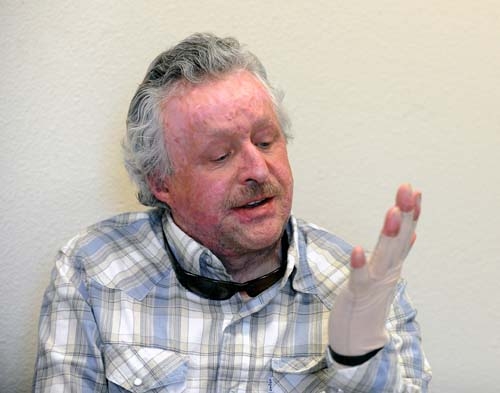Patients have UMC burn center to thank for recovery

Burns covering 85 percent of Charlie Kleck’s body serve as his only reminder of a boating accident on Lake Powell in Arizona last summer.
The 54-year-old has one vivid memory of watching sections of his chest "turn into gel" and fall onto his feet as he stood in the sand. Kleck was twice revived in the helicopter on the way to the Lions Burn Care Center at University Medical Center and during one of his more than 30 surgeries. He spent three months at the center before heading to Phoenix to be closer to family.
The burn center is the only one in the state treating severely burned patients in Nevada and in parts of Arizona, California and Utah. The center boasts a 94.6 percent survival rate for the 200 to 250 patients annually in care and 10,000 in outpatient care. There are both adult and pediatric departments. A quarter of the patients admitted are younger than 18.
"Burn victims need this kind of experienced help," Kleck said. "Without places like this, your chances are zero. You have zero chance of surviving."
The accredited center is working to become verified by the American Burn Association by 2014. That verification will make the center eligible for federal grants to help alleviate millions of dollars in hospital costs charged to patients once their insurance benefits are used up, said Mary Martinat, outpatient manager.
The center provides patients with specially trained burn physicians, burn care nurses, pharmacists, dieticians, social workers, therapists and the only hyperbaric chamber of its kind west of the Mississippi. It infuses oxygen into patients for wound and burn treatment.
But getting the word out about the center has been difficult, Martinat said.
"People don’t know about what’s here and what we do," she added.
Patient Jorge Hernandez survived a car explosion during an accident Las Vegas he can’t remember. The 28-year-old lost both of his legs and a finger. His kidneys were functioning at 10 percent at one point.
"With faith, love and hope I rose above the flames," Hernandez said.
He now plays wheelchair rugby and has a new appreciation for life, religion and family.
UMC’s burn center has come a long way from its four beds in 1964 to its multimillion-dollar tower built in 2010 with 16 to 25 beds.
Martinat, who began her career at UMC as a trauma intensive care nurse in 1991 and transferred to the burn unit in 2005, said the most common burns are smokers who use oxygen tanks, tourists suffering from pavement burns on their feet and New Year’s revelers who try to barbecue once the partying stops.
Hospital officials hold an annual tour for high school students, media and other employees about the facility and the resources available. On Thursday, workers at the center showed how they cleanse burns from infection by removing dead tissue. That is a prime area for infections to grow, Martinat said.
Two volunteers with makeup to give the appearance of severe burns laid on tables while officials discussed how the wounds are cleaned.
Intensive care units were opened as officials used mannequins to show how severely burned people are cared for. Those units are kept at a balmy 90 degrees to keep patients’ temperatures stable. Large monitors simulated breathing and blood pressure levels. Staffers were clad in masks, gloves and yellow robes to show how they keep patients safe from infection.
The center that treats the severely burned also works to educate about burn prevention, Martinat said.
Contact reporter Kristi Jourdan at kjourdan@review journal.com or 702-455-4519.